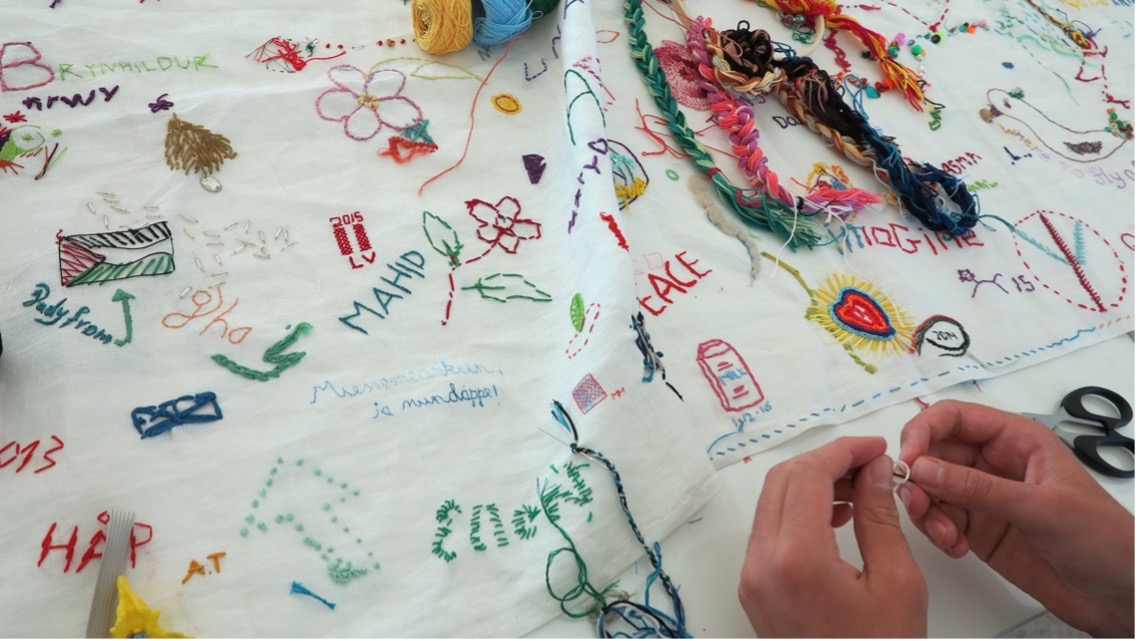The stitch project
Traces of diapraxis and al masha within participatory textile projects
DOI:
https://doi.org/10.7577/ar.5796Keywords:
participatory art, embroidery, textile, al masha, diapraxisAbstract
In this article, I shall discuss participation – the artist's role and responsibility in participation, and the potentials of participatory textile projects in the public space. In doing so, I will focus on The stitch project (2012–). This project involves public interaction through acts of tactile textile making such as stitching on a tablecloth. I have based this study within a context of understanding matter and the embodiment of participation from feminist (Ahmed, 2006; Butler, 1988) and new materialist (Barad, 2003; Coole & Frost, 2010; Garber, 2019) perspectives. I am interested in the interactive aspects of The stitch project and how these aspects relate to the concepts of diapraxis (Nunes, 2019) and al masha (Hilal & Petti, 2018). In regard to these terms, I aim to examine the potentials and challenges of participatory textile art projects, like The stitch project, by examining their social and material aspects as well as the complexities of inclusion and participation.
References
Ahmed, S. (2006). Queer phenomenology: orientations, objects, others. Durham: Duke University Press.
https://doi.org/10.1515/9780822388074
Ahmed, S. (2019). What's the Use? On the Uses of Use. Durham, London: Duke University Press.
https://doi.org/10.1215/9781478007210
Almaany (n.d.) مشاع . Retrieved October 29 from https://www.almaany.com/en/dict/ar-en/مشاع/
Barad, K. (2003). Posthumanist Performativity: Toward an Understanding of How Matter Comes to Matter. Signs, 28(3), 801-831.
https://doi.org/10.1086/345321
Barney, D., Coleman, G., Ross, C., Sterne, J., & Tembeck, T. (2016). The Participatory Condition. An Introduction. In D. Barney, G. Coleman, C. Ross, J. Sterne, & T. Tembeck (Eds.), The Participatory Condition in the Digital Age (pp. vii-xl). Minneapolis: University of Minnesota Press.
Bhabha, H. K. (1994). The location of culture. London: Routledge.
Bherer, L., Dufour, P., & Montambeault, F. (2016). The participatory democracy turn: an introduction. Journal of civil society, 12(3), 225-230.
https://doi.org/10.1080/17448689.2016.1216383
Boomgaard, J. a. R. B. e. (2017). Being Public: How Art Creates the Public (Making Public). Amsterdam: Valiz.
Braidotti, R. (2019). Posthuman knowledge. Medford, MA: Polity.
Bryan-Wilson, J. (2017). Fray: Art and Textile Politics. Chicago: University of Chicago Press.
https://doi.org/10.7208/chicago/9780226369822.001.0001
Burisch, N. (2016). From Objects to Actions and Back Again: The Politics of Dematerialized Craft and Performance Documentation. Textile, 14(1), 54-73.
https://doi.org/10.1080/14759756.2016.1142784
Butler, J. (1988). Performative Acts and Gender Constitution An Essay in Phenomenology and Feminist Theory. Theatre Journal, 40(4), 519.
https://doi.org/10.2307/3207893
Coole, D., & Frost, S. (2010). New materialisms: ontology, agency, and politics. Durham & London: Duke University Press.
https://doi.org/10.2307/j.ctv11cw2wk
Coumans, A. (2017). Art as Encounter. In J. B. R. Brom (Ed.), Being public: how art creates the public. Amsterdam: Valiz.
Deadman, R. (2018). Labour of Love, New Approaches to Palestinian Embroidery. In Palestine Museum (Ed.). Birzeit.
Finkelpearl, T. (2014). Participatory Art. In M. Kelly (Ed.), Encyclopedia of Aesthetics. New York: Oxford University Press.
Garber, E. (2019). Objects and New Materialisms: A Journey Across Making and Living With Objects. Studies in Art Education, 60(1), 7-21.
https://doi.org/10.1080/00393541.2018.1557454
Hilal, S., & Petti, A. (2018). Permanent temporariness. Stockholm: Art and Theory Publishing.
Kawar, W. K. (2011). Threads of Identity: Preserving Palestinian Costume and Heritage. Limassol, Cyprus: Rimal Publication.
Kwon, M. (2002). One place after another: site-specific art and locational identity. Cambridge, Mass: MIT Press.
https://doi.org/10.7551/mitpress/5138.001.0001
Merriam-Webster. (n.d.). Stitch. In Merriam-Webster.com dictionary. Retrieved November 17, 2019, from https://www.merriam-webster.com/dictionary/stitch
Mitchell, V. (2013). Dialog stitching with metonymy. Textile, 11(3), 314-319.
https://doi.org/10.2752/175183513x13793321037601
Nunes, D. F. (2019). The Power of Listening: Diapraxis, Play and Another Grammar for the City. Oslo Biennalen First Edition 2019 - 2024: New, Ongoing and Completed by October 2019. Kulturetaten Oslo kommune.
Weizman, E. (2010). Introduction. In M. Miessen (Ed.), The nightmare of participation: (crossbench practice as a mode of criticality) (pp. 9-12). New York: Sternberg.
Wiktionary (n.d.) Action. Retrieved November 17, 2019 from https://en.wiktionary.org/w/index.php?title=action&oldid=78207185

Downloads
Published
How to Cite
Issue
Section
License
Copyright (c) 2024 Marie Skeie

This work is licensed under a Creative Commons Attribution 4.0 International License.
Authors who publish with this journal agree to the following terms:
- Authors retain copyright and grant the journal right of first publication with the work simultaneously licensed under a Creative Commons Attribution License that allows others to share the work with an acknowledgement of the work's authorship and initial publication in this journal.
- Authors are able to enter into separate, additional contractual arrangements for the non-exclusive distribution of the journal's published version of the work (e.g., post it to an institutional repository or publish it in a book), with an acknowledgement of its initial publication in this journal.
- Authors are permitted and encouraged to post their work online (e.g., in institutional repositories or on their website) prior to and during the submission process, as it can lead to productive exchanges, as well as earlier and greater citation of published work (See The Effect of Open Access).